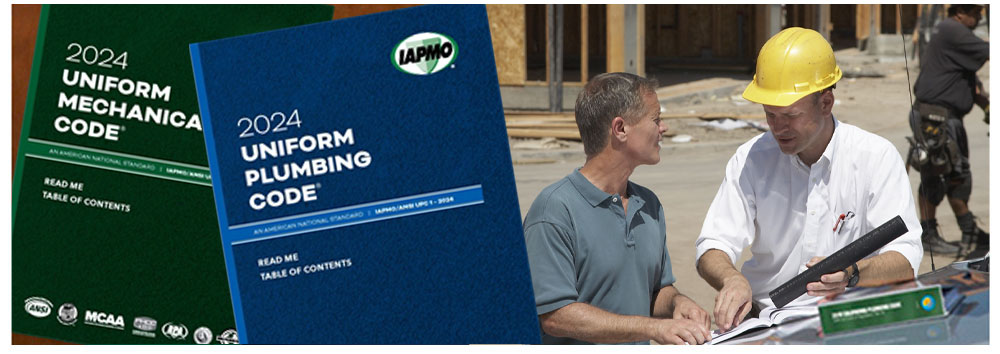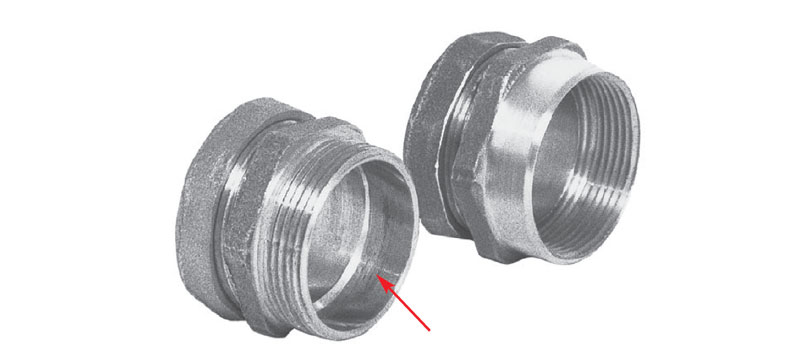November 7, 2024

From the 2024 UPC Illustrated Training Manual, Chapter 10 – TRAPS AND INTERCEPTORS
1003.2 Slip Joint Fittings. A maximum of one approved slip joint fitting shall be permitted to be used on the outlet side of a trap, and no tubing trap shall be installed without a listed tubing trap adapter. Listed plastic trap adapters shall be permitted to be used to connect listed metal tubing traps.
This would allow the slip joint on a trap arm extension or a 45-degree offset. Remodeling a sink cabinet is an application where such a slip joint may be needed. The new cabinet may offset the fixture trap from the waste connection. To reconnect the trap to the existing trap adapter, a slip extension piece or a 45-degree offset slip joint may be needed.
An approved trap adapter must be used at the connection of the trap arm to the drainage fitting. Whether it is a plastic pipe end or a galvanized nipple, a trap adapter must be used. The adapter prevents the trap arm from extending too far down the drainage pipe or, if placed close to the waste and vent connection, from passing into the drainage fitting and blocking the waste or airflow (see Figure 1003.2).

TRAP ADAPTER – NOTICE STOP FOR P-TRAP ARM
From the 2024 UMC Illustrated Training Manual, Chapter 8 – CHIMNEYS AND VENTS
803.2.21 Vent Connector Sizing. Vent connectors shall not be increased more than two sizes greater than the listed appliance categorized vent diameter, flue collar diameter, or draft hood outlet diameter. Vent connectors for draft hoodequipped appliances shall not be smaller than the draft hood outlet diameter. Where a vent connector size(s) determined from the tables for a fan-assisted appliance(s) is smaller than the flue collar diameter, the use of the smaller size(s) shall be permitted, provided that the installation complies with all of the following conditions:
(1) Vent connectors for fan-assisted appliance flue collars 12 inches (300 mm) in diameter or smaller are not reduced by more than one table size [e.g., 12 inches to 10 inches (300 mm to 250 mm) is a one-size reduction] and those larger than 12 inches (300 mm) in diameter are not reduced more than two table sizes [e.g., 24 inches to 20 inches (600 mm to 500 mm) is a two-size reduction].
(2) The fan-assisted appliance(s) is common vented with a draft hood-equipped appliance(s).
(3) The vent connector has a smooth interior wall. [NFPA 54:13.2.24]
A sudden, large expansion of the vent connector diameter creates a pressure drop that may limit the draft and encourage condensation. Therefore, this section places a limit on upsizing, limiting the vent connector diameter to two sizes larger than one of the following that is applicable:
- Appliance categorized vent connector diameter
- Flue collar diameter
- Draft hood outlet diameter
Note that an appliance includes either a draft hood or flue collar for connection to the vent or vent connector. The term “Appliance categorized vent diameter/area” is defined as follows:
The minimum vent area/diameter permissible for Category I appliances to maintain a nonpositive vent static pressure when tested in accordance with nationally recognized standards.
Therefore, where connecting an appliance to a vent connector, use the applicable tables in Section 803.0 to find the minimum size vent connector.
Note that only smooth wall vent connectors may be downsized. It would also be advisable to check with the manufacturer to make sure it allows a downsizing.
(This is not to be considered the official position of IAPMO, nor is it an official interpretation of the Codes.)

IAPMO
IAPMO develops and publishes the Uniform Plumbing Code®,the most widely recognized code of practice used by the plumbing industry worldwide; Uniform Mechanical Code®; Uniform Swimming Pool, Spa and Hot Tub Code®; and Uniform Solar Energy, Hydronics and Geothermal Code™ — the only plumbing, mechanical, solar energy and swimming pool codes designated by ANSI as American National Standards — and the Water Efficiency Standard (WE-Stand)™. IAPMO works with government, contractors, labor force, and manufacturers to produce product standards, technical manuals, personnel certification/educational programs and additional resources in order to meet the ever-evolving demands of the industry in protecting public health and safety.
Last modified: November 7, 2024
